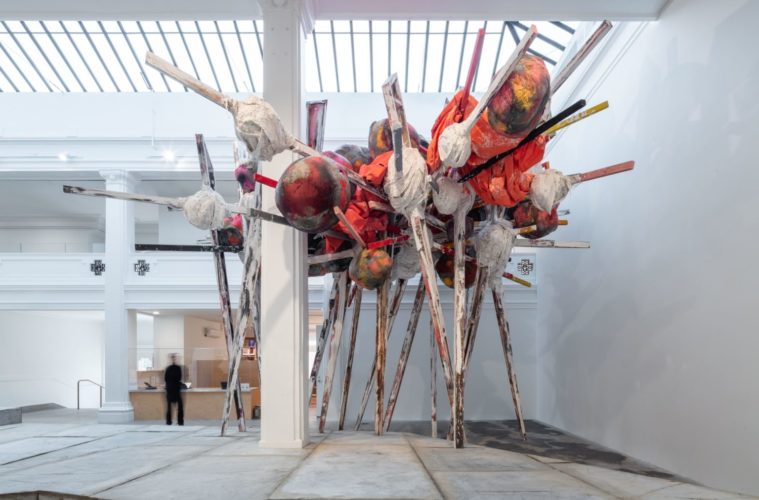British artist Phyllida Barlow is iconic in UK art circles, where her long career challenging the material and aesthetic hierarchies of contemporary sculpture has made her a beloved teacher, a cultural game-changer and an accidental feminist icon. Despite this being her first solo exhibition in Los Angeles, her arrival was much anticipated by this city’s community of artists, especially women, who have long been inspired by her mold-breaking, muscular style of elevating unconventional materials into ambitious, architecturally responsive process-based works and installations — such as the overwhelmingly tactile, poetically disorienting, assertively mysterious intervention and assembly currently on view at Hauser & Wirth downtown.
As it turns out, the soaring spirit of adventure in American mid-century sculpture and land art was a huge influence on her early practice, as was the Arte Povera movement of the 1960s. When she began her career, the English art world was still in thrall to tradition; modernism had challenged certain priorities in contemporary art, but there was a long way to go to arrive at a truly new place. And as Barlow tells L.A. Weekly, “As the ‘60s progressed, it was like breaking free. It was just like the world was being opened up imaginatively and intellectually, especially in ways of realizing the object, and letting action and materiality take over.”
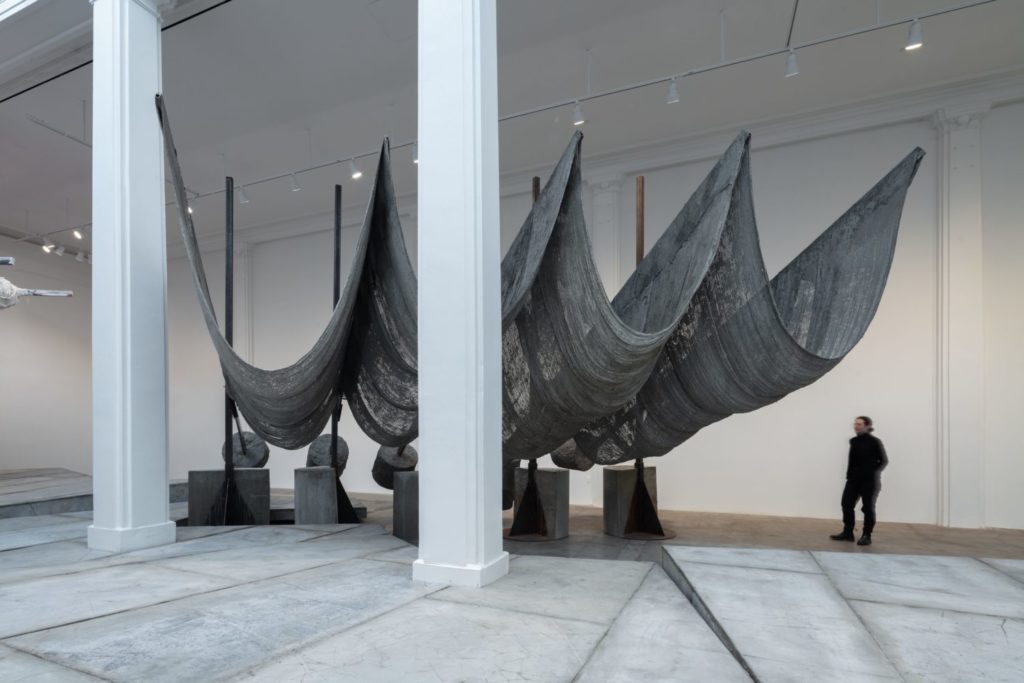
As for being an icon of women’s art, Barlow adds, “There’s one thing I want to say about the feminist aspect of it. I found the wave of feminism in the ‘70s very difficult and problematic because my idea of being an artist and fighting to survive was to distill as much as I could from the lineage of sculpture. And that meant even though I don’t think I knew the word ‘macho’ at that time, it meant stealing very masculine attitudes to making. And I think perhaps I interpreted them as a kind of aggression, and a commitment that I wouldn’t let things elude me. It was definitely a fight — cutting, breaking things, knocking down buildings. I was not interested in following a careful discipline.”
Five decades on, Barlow’s work has only grown in scale and ambition, as well as the spirit of experimentation and the bravado required on site-specific installation. Entering the gallery at Hauser & Wirth, there’s a pronounced emotional experience encountering the work, not only because of its surprising scale. Its raw, construction-site sensibility and the illusion of precarity within its mass engages with the body in a direct, visceral way that is only amplified on approach, as the thousands of layers of laid-in mediums evoke roughness in skin and bone, as much as roughness in architectural surrealism. The massive central exhibition — a concrete platform, a free-standing sweep of ghostly post-palatial staircases, a phalanx of heavy concrete sails, and a carnival of bright stilt-walking fabric orbs — occupies and activates the unexpected entirety of the space.
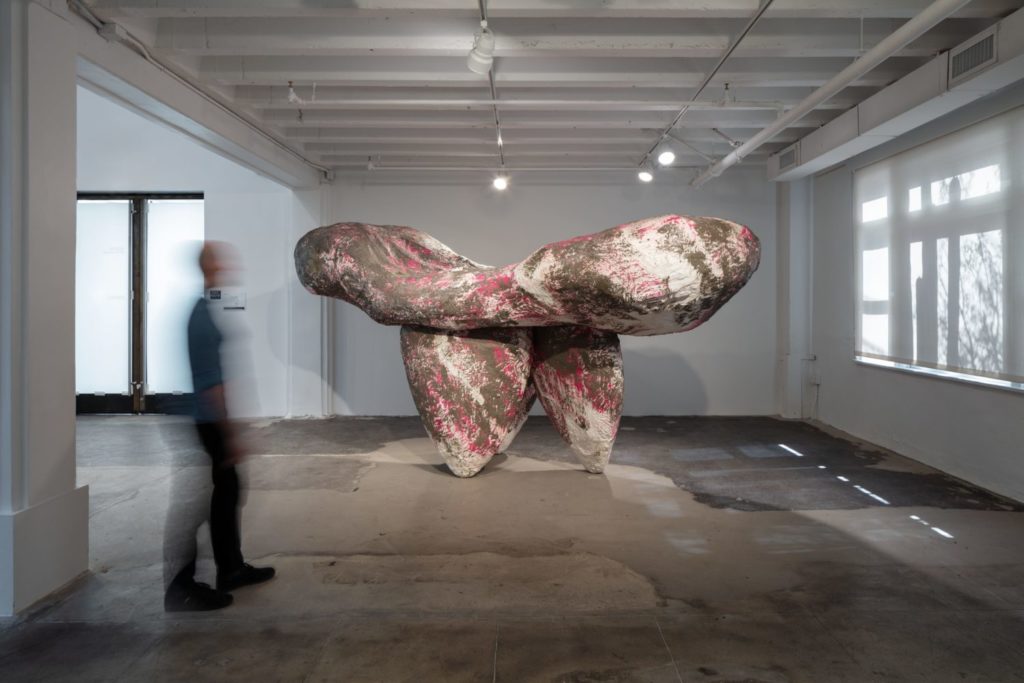
Installation view: Phyllida Barlow. glimpse at Hauser & Wirth Los Angeles, 2022 (© Phyllida Barlow. Courtesy the artist and Hauser & Wirth. Photo: Zak Kelley)
An accompanying suite of stand-alone sculptures utilizes the same language of materials and quasi-anthropomorphic forms but extend an intimate hand of self-contained narrative that greets rather than subsumes the viewer. This contingent of large forms is invented, heavy abstractions. Their shapes and surfaces are conflictual in a way, in that their biology, their overweight haunches and obscured or absent features, are all the kind of things that contradict a conventional notion of beauty. Anthropomorphic but ambiguous, titled and tactile in a way that both beckons and refuses complete comprehension, they ultimately leave the viewer in a state of want, memory and mystery. One imagines them occupying and transforming any manner of site or environment once they’ve taken leave of the gallery. The installation on the other hand, is harder to imagine transplanted — though in a bit of a change for Barlow, it is technically movable.
For an artist best known for her improvisational, almost performative generation of site-specific installations — the kind of thing one watches being created, experiences, and then witnesses as it is inevitably destroyed as it cannot be viably removed — the works on view here (both the sculptures and the installation) have been executed and installed, with an eye toward their own survival when the show ends its run. Nevertheless Barlow has remained determined to keep that spirit of improvisation ever-present in her process.
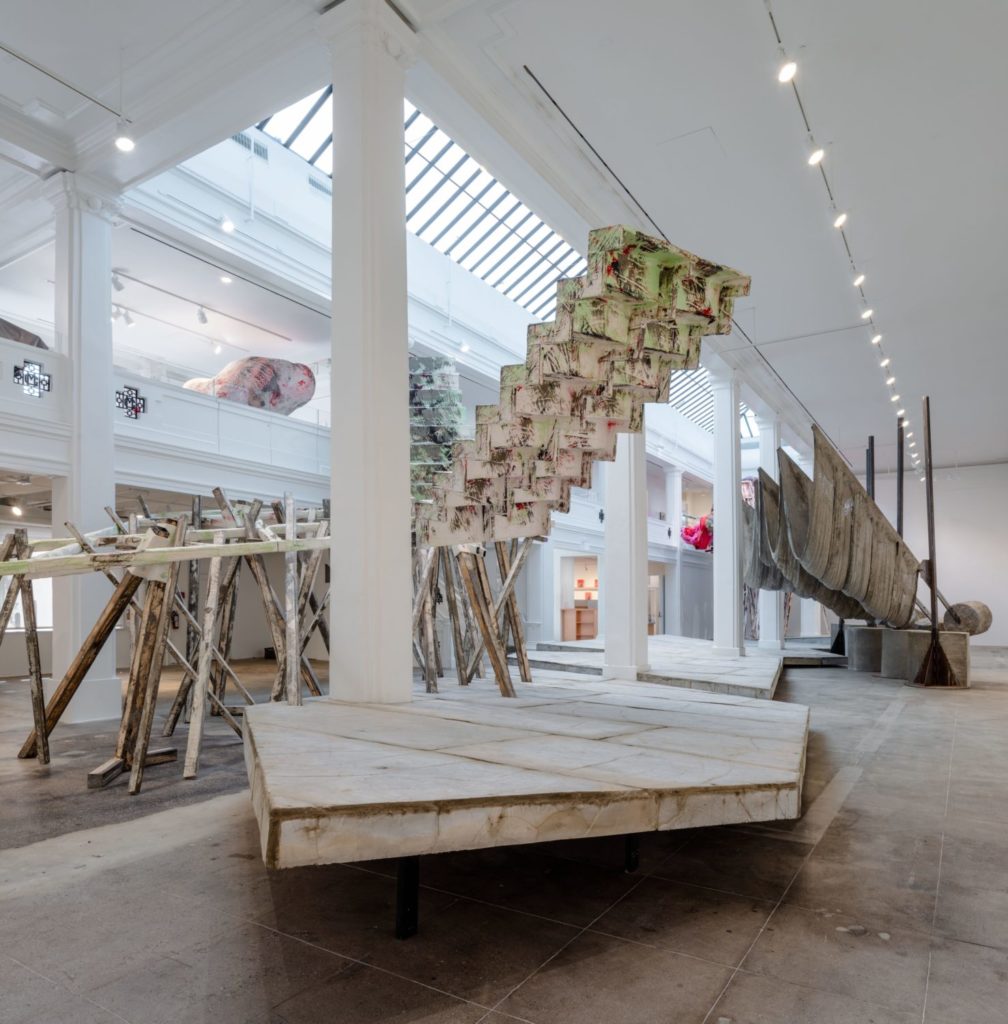
Installation view: Phyllida Barlow. glimpse at Hauser & Wirth Los Angeles, 2022 (© Phyllida Barlow. Courtesy the artist and Hauser & Wirth. Photo: Zak Kelley)
“I think the way of improvising was ingrained in me as a way of making from really the late ‘80s onwards,” Barlow says. “I am very familiar with ways of making, whether it was with tape wrapping and binding or other forms of fixing that were quick and easy and using light materials, that meant that I could go to a venue and build in any way I wanted. Then that developed over, say, 15 or 20 years, until 2010, when I was approached by Hauser & Wirth to join the gallery. And then I had to relook at the way I had been working, which was very much event-based. I’d go into a gallery and I would build into that space. And the thing that I found the really exciting adventure was the challenge to make the sculpture do things for me that I was physically attracted to doing — like going up into the ceiling, raising the eye level in the whole physical encounter with the space — to become a reality through the development of other techniques that meant that the sculpture wasn’t just destroyed at the end.”
There’s a certain kind of energy that’s incredibly important to Barlow, to be able to take what is usually used in the studio in that way to a museum, so it’s not just opening up a crate there, but it’s actually working into the space and seeing what will happen. Barlow still takes great joy and satisfaction in showing up at the space to find stacks of wood and sacks of cement, and piles of tarps and all the paint. It’s not only like a construction site — it literally is a construction site. “It’s like aspects of the way I work in the studio anyway, so it’s very much taking the studio to space,” Barlow says. “It’s just important to be able to keep a certain kind of anarchic way of working alive and kicking, you know? That has great potential.”
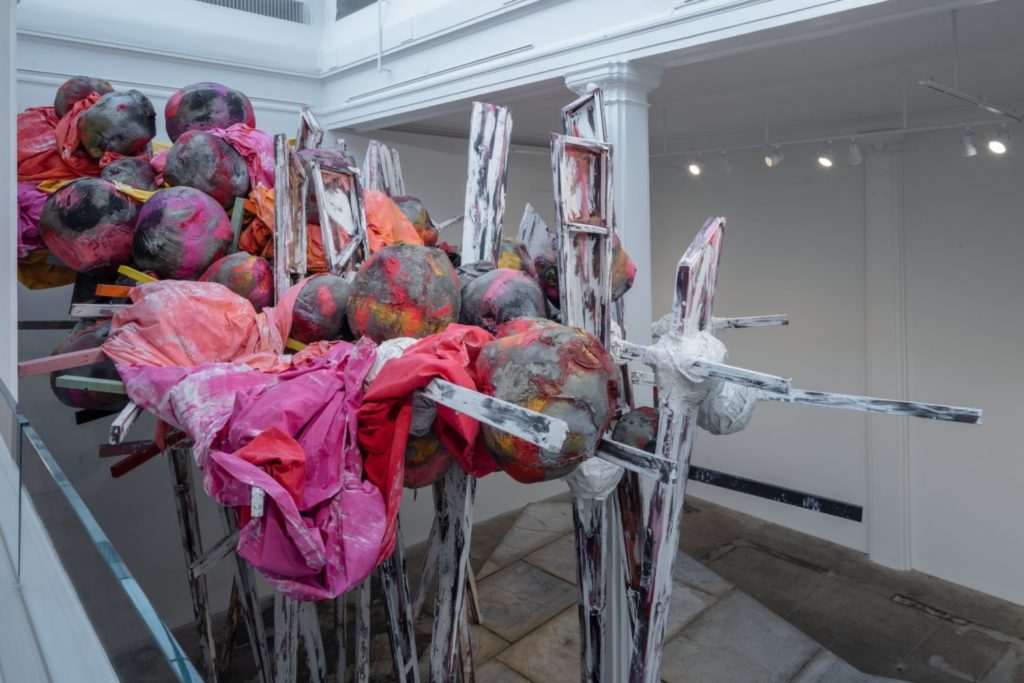
Installation view: Phyllida Barlow. glimpse at Hauser & Wirth Los Angeles, 2022 (© Phyllida Barlow. Courtesy the artist and Hauser & Wirth. Photo: Zak Kelley)
Many of Barlow’s materials truly look found and salvaged. The operatic ghost staircase in the center of the gallery particularly seems rescued from a tear-down. Are her materials rescued from destruction, or purposely new-built as ruins? For Barlow, this is a tricky question to answer. “It involves the language of my preferred aesthetic, which is the worn and the damaged, the broken,” says Barlow. “And I think there’s a danger of that being an affected style. I know they talk about grunge chic and that kind of thing. And I understand that the expressionist gesture can be just a mannerism, wherein what was once a kind of emotive act very quickly becomes a style that uses the intensity of the original discovery of the quick mark or the gestural mark. And I feel vulnerable to being exposed to that in some way.”
Barlow says she pushes back against this entropy of critique by her deliberateness in exposing her methods of production, and suggesting in form and material that the work is, or may well be, unfinished. “That there’s some quality about it that allows for the generosity that it could go on, that there’s a potential that more could happen. And I think that’s really more what my aesthetic is about,” she says. “I don’t mind if it’s my sort of signature, but I don’t want it to become a style with no content behind it.”
It’s with that in mind that the staircase presents itself as the cornerstone of her response to the particulars and historical uses of the gallery’s location. A staircase is an archetypal memory, from childhood perhaps, a symbol of movement and passage, above and below, departure and arrival. But there’s also a staircase at the edge of the gallery, and she wanted to both shadow it and remove it to the center of the room — as well as use the upstairs mezzanine as a site for sculptural objects and a viewing platform to look down at what had previously required looking up. As it turns out, this push and pull of absorbing the body, then urging its movement across the installation and throughout its chambers, is more than a manifestation of Barlow’s taste for site specificity — though it is most certainly that. It also is a manifesto of her foundational ideas of what sculpture is, and what it does.
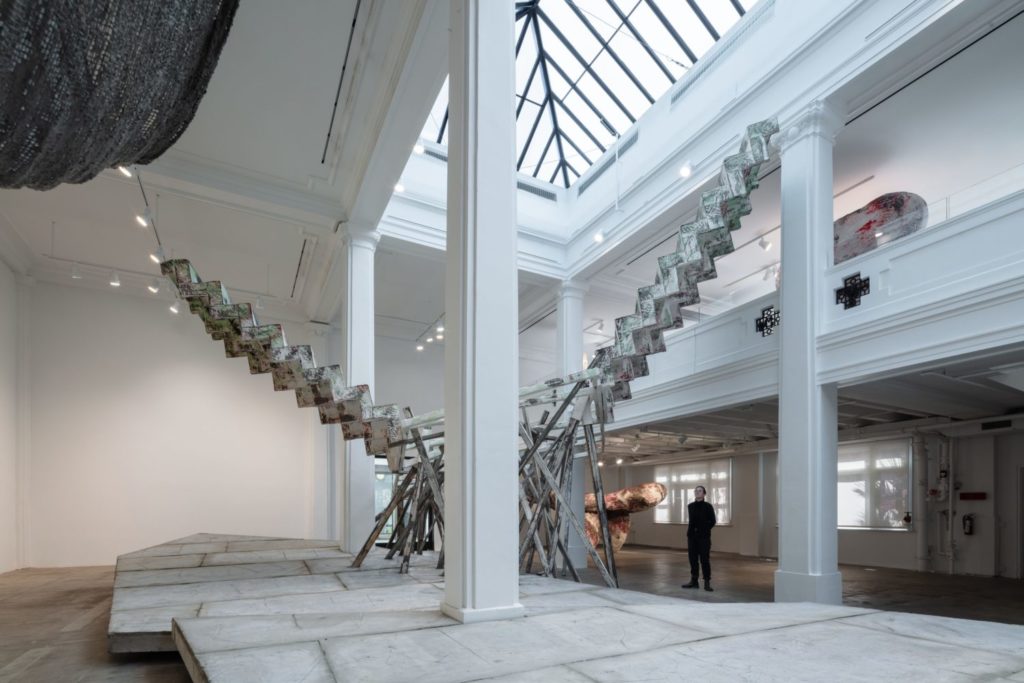
“There are many ways you can view art, but there are two fundamental ones,” Barlow says. “As the passive viewer and the active viewer,” and they’re oddly paradoxically in contradiction to what one might think. “The passive viewer is the one who is watching the performance where the performance comes to you, and in a way you’re sort of fixed in one spot as the work comes to you. Therefore, the work is active and you are passive. And then there’s my work — when the work is passive, but it demands the active engagement of the viewer. The viewer has to make an effort to become involved. The still silence of sculpture requires a particular kind of engagement from the viewer, which is very different from watching a performance. We live in the age where performance art and video, and all these things are incredibly important,” she says. “What is great is, I think they challenge the more traditional disciplines. And that’s what we need as artists. We need those sharp reminders.”
Phyllida Barlow: glimpse is on view at Hauser & Wirth in the downtown Arts District through May 8. Visit hauserwirth.com for more information.
Advertising disclosure: We may receive compensation for some of the links in our stories. Thank you for supporting LA Weekly and our advertisers.

